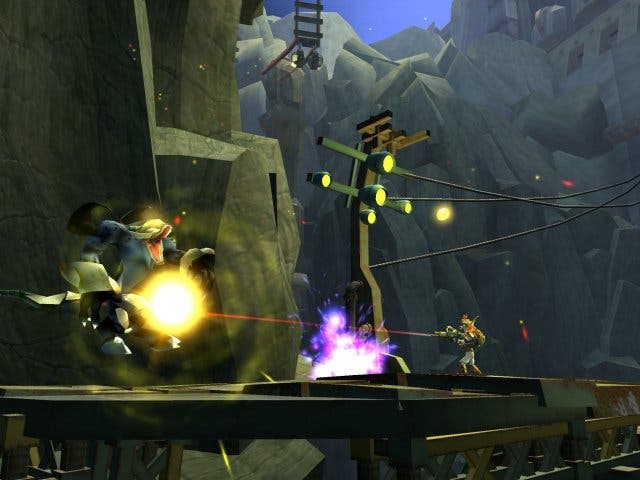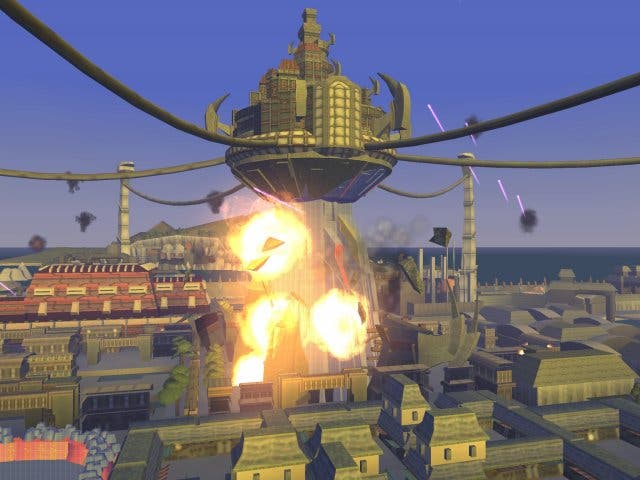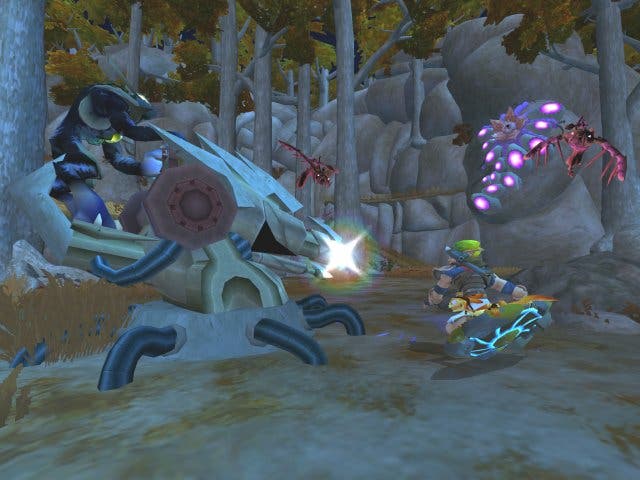Jak 3
We go hands on with the concluding chapter in Naughty Dog's trilogy, and chat to game directors Evan Wells and Amy Hennig about what comes next, how the game fits in with previous instalments, and the speed with which it's all come together.
Is this the end of Jak & Daxter? With Jason Rubin on his way out of Sony-owned developer Naughty Dog, and press releases flying around discussing the end of the trilogy, it's easy to get the wrong impression. "You know, we're not killing Jak or Daxter off," game director Evan Wells jokes at one point during a presentation of Jak 3, the latest instalment in the platform-cum-action-adventure series. "The franchise will continue on and there may be more games in the universe." The question, then, is not so much what happens to Jak and Daxter next, but what happens in their world - and what happens to the developer post-Rubin? It's a question Naughty Dog probably doesn't know the answer to yet.
In fact, talking to Evan Wells and his colleague Amy Hennig from Naughty Dog, it's easy to get the impression that the whole thing is quite a seat-of-the-pants operation. Both seemed very receptive when we asked about the possibilities of developing secondary characters into the primary focus for future instalments. "Like a side-story or something? Sure!" But although, as Hennig points out, "there are a lot of strong characters in there," it doesn't seem like there's a solid plan yet. "We're always thinking of ideas and we've got more ideas than we possibly have time to implement," Wells responds to a question about what happens next. "We know we want to answer the questions that people might have been asking since the early games." For now though, that's Jak 3's job, and there is a pervading sense that this is the end of the story, even if it isn't the end of the line.
Changes Afoot

As finales go however, this one is certainly brimming with potential. The Grand Theft Auto-esque approach of an open cityscape full of loosely-related platform and action levels and colourful characters remains from the second game, as do the original's trademark platform missions, fetch quests and vast, interconnected environments. However there are plenty of new elements in place - sub-games, even near-rhythm-action segments, and shooting gallery-style affairs - and dune buggy sections set in the wastelands outside Haven City, the walled-in dystopian setting for Jak II.
Meanwhile, the collect-'em-up element seems to have been diluted somewhat. In the first game, it was all about collecting precursor eggs and power cells while bopping around cunningly engineered platform worlds that were all intrinsically linked somehow; in the second there was a heavy emphasis on collecting Metal Head gems. In the missions we've seen and played so far in Jak 3, while there are still plenty of collectibles, including the aforementioned eggs, Dark and Light Eco globules that power Jak's special abilities and the like, the focus seems to have shifted more to a wide variety of different gameplay styles - even aerial combat - and the emphasis is much more firmly on driving the narrative by completing them.
But then surely that's what you'd expect from the concluding part of a trilogy. And, for its many fans, the story is bound to be the biggest hook on offer. Perhaps that's why our presentation began with a walk through the dramatic animated movie sequence that kicks the whole thing off, as Jak and Daxter are booted out of Haven City by a sinister and officious individual by the name of Vegor. As it turns out, following the events of the second game, the whole city was plunged into chaos, culminating in the disintegration of the palace at its heart, which plunges to earth, flattens a great deal of the city in the process and cracks open the very heart of the planet. It seems that in the face of the renewed Metal Head onslaught, Jak and Daxter bear the full brunt of the population's discontent, and Vegor winds up banishing the pair.
"After Jak II ended, for a very brief moment there was peace and prosperity in Haven City, and during that time [Vegor] rose up to power and he's the new leader of a group that the underground, who went into a more formalised government, set up called the Freedom League," Wells explains. "He's almost like a religious zealot and he really thinks that Light Eco is the only good thing and that anything Dark should not exist. He wants to destroy all elements of Dark Eco in the world." Given Jak's decidedly tainted make-up - the product of endless torture sessions at the hands of one of his chief adversaries in last year's Jak II - it makes him an obvious target.
From Darkness Comes Light

But Jak's not all dark. Not this time. Freshly ejected from Haven City, he, Daxter and Pecker - the equally mouthy bird from Jak II and arguably one of most inspired new elements of that game - wind up in wasteland city Spargus, and Jak's forced to rebuild his reputation in a similar, albeit augmented, manner to previous instalments. Fortunately, he's got a few new tricks hidden in his little green beard, one of which is making use of Light Eco.
Light Eco, much like Dark Eco, transforms Jak into another form. In his angelic, winged Light Eco alter-ego, Jak can not only heal himself gradually - at the expense of any Light Eco he happens to have collected, fairly obviously - but he can also glide around on the breeze, reaching previously unreachable areas and adding another dimension to the general exploration. However Hennig is at pains to make clear that the clash of Dark and Light isn't quite as black and white as it might be in other games. "Actually, what's important is the balance," she muses. "It's not like you can go too far to the Dark or too far to the Light. Jak's very unique in that he's a balanced creature."
Another eye-catching addition is the sequence of driving missions, which take Jak and crew out into the wastelands surrounding Spargus and Haven and see them bouncing around collecting items, blasting giant lizards and even racing into the heart of a mine. And rather like Jak II's GTA-style open world, the developer is happy to credit its inspiration; curiously, another Rockstar Games title, Smuggler's Run. "Absolutely," Wells beams when we ask if SR was maybe a bit of an influence there. "We wouldn't deny that one bit! That's a great game," he enthuses, "and we definitely played that at the Naughty Dog offices, and we're hoping that we'll be able to have stuff that's equally as fun."
If that's the goal, it's certainly close to achieving it. Driving missions run along the same lines as Smuggler's Run, as well as emulating the bouncy suspension and control mechanics. In one example, the player has to chase down packages marked on the mini-map - packages which also benefit from a shaft-of-light-from-the-heavens indicator - while in another the idea is to bring down dinosauric lizards with enemies mounted on their backs, all the while we're dodging bony trees poking out of the sand and roaring over immense, undulating sand dunes and flying over the occasional stream off mildly contrived rocky ramps. In a third, which benefits from much bouncier suspension, Jak finds himself reunited with Sig from the second game, and the player controls both as they hurtle around a cave network blowing up eggs caked to rock and ceiling and fighting off swarms of unknown enemies, before racing back to the city in time for tea.
The Bigger Picture

There's no denying that it's a very varied undertaking, although it's obviously difficult to say where the balance will lie based on our experience with only a handful of missions. Indeed, rather like the demos that preceded Jak II's release at E3 last year, the traditional platforming - which still formed a core component of the middle game in the trilogy - takes something of a back seat to new pursuits, like a stationary gun emplacement shootout, where Jak has to fire his way through a series of attacking enemies and try to beat a high score; and a section where Jak tries to crack into a dormant precursor artefact by pressing the controller's face buttons in time as their respective icons move towards the centre of the screen.
Nevertheless we certainly expect to see plenty of platforming in the final game. One of the most Jak-esque missions in the entire demo version consists of a trek up the side of a mountain, platforms flipping up and around, Metal Heads swarming towards Jak - whose newly upgraded weapons benefit from ricochet functions and other explosive improvements - and it's here that there's the most sense of the Jak we knew. Equally, the jet-board and Titan Suit are primed to reappear, and the former ought to speed up city travel, in-between hotwiring the usual array of hover-cars.
One thing we did wonder about playing the demo version though was those big lizards. Surely we get to ride those? "You can't ride the bigger ones," Wells admits, somewhat apologetically. "But that would be really cool..." Hennig offers consolingly. Okay, so do that, we instruct them. They laugh. "It's not that hard actually," says Hennig. "That's the beauty of it. Once we get an idea... Some companies would just be like, 'No, it's too late, we can't implement that', but sometimes we think 'We could do that actually' and a day later there it is in the game."
Leaving A Precursor Legacy

It's certainly clear that Naughty Dog works at quite a pace. A naturally technology-driven company, this third game has come about in the relative blink of an eye, given that the technology is largely unchanged. As a result, neither Wells or Hennig seems phased - or particularly exhausted. "There's a lot of momentum on the team," Hennig confirms. "It's about a 50-person team, the technology was there, we didn't really miss a beat and so the ability to just to be able to move from one thing into the next - to work through Jak II to Jak 3 - was really helpful." In fact, she says, the version we're looking at only represents about six months worth. "And of course there's lots you're not seeing, too," she beams.
Based on what we do see, however, it's difficult to decide how the game will turn out. It's clearly built on some solid foundations. The technology behind Jak II may not have evolved much in the intervening period (although it clearly has to some extent judging by some of the rolling vistas and vast play areas on offer), but it was enviable enough PS2 tech in the first place, and at times - particularly during movie sequences - it borders on cartoon quality. Character animation, most notably facial animation, is emotive in ways the first game would have had trouble understanding, and the smoothly contoured art style is very easy on the eye. It's also still a lot of fun to play, even in the fits and starts of a disjointed presentation version, and given the developer's assertion that it's much, much bigger - Haven City is actually just an unlockable section here - it should have plenty of opportunity to flesh out its own ideas.
Except, not a lot of them are the developer's own ideas. It may sound harsh, but plenty of the things that made the first two Jak titles enjoyable - and a number of elements that drive the progress of the third instalment - are simply refinements of existing theory. Then again, if they remain fun, they remain fun. We'll reserve judgement for now. What we will say, however, is that in seeking to concoct something out of a mishmash of different ideas, the developer has certainly had plenty of opportunity to deliver the narrative it desires, and we fully expect Jak 3 to be a feast for fans primarily for this reason. Indeed, it's the idea of exploring the shattered warzone that used to be Haven City that excites us most, and probing deeper into the planet core "where the big mystery lies," according to Hennig and Wells. Question marks still linger over whether the mishmash can sustain us for the course of the story, and we're certainly hoping that the difficulty spikes in the second game have been ironed out this time, but if this is to be the end of Jak and Daxter, at this stage we reckon it might satisfy.
Jak 3 is due out on PS2 in late 2004.

